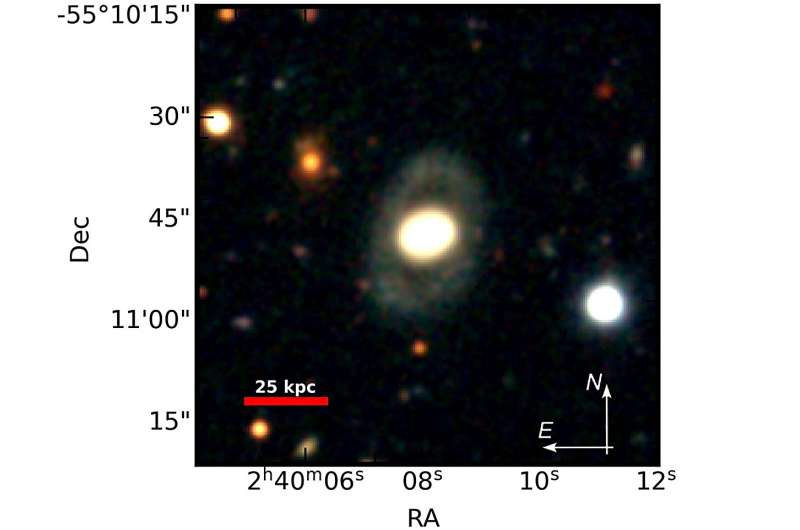September 5, 2023 report
This article has been reviewed according to Science X's editorial process and policies. Editors have highlighted the following attributes while ensuring the content's credibility:
fact-checked
preprint
trusted source
proofread
New ring galaxy discovered by Indian astronomers

By analyzing the data from the Dark Energy Camera Legacy Survey (DECaLS), astronomers from the Christ University in Bangalore, India, have serendipitously discovered a new ring galaxy, which received designation DES J024008.08-551047.5 and may belong to the rare class of polar ring galaxies. The finding was reported in a paper published August 29 on the pre-print server arXiv.
The so-called polar ring galaxies (PRGs) are systems composed of an S0-like galaxy and a polar ring, which remain separate for billions of years. In general, these outer polar rings, composed of gas and stars, are aligned roughly in a perpendicular orientation with respect to the major axis of the central host galaxy.
However, although more than 400 PRG candidates have been discovered to date, only dozens of them have been confirmed as real polar ring galaxies by follow-up spectroscopic observations.
Now, a team of astronomers led by Akhil Krishna has detected another PRG candidate. The detection of DES J024008.08-551047.5 (or DJ0240) was made during visual observations of optical imaging data from DECaLS.
"We discovered the galaxy DJ0240 as a potential PRG candidate with a ring component positioned almost perpendicular to the host galaxy," the researchers wrote in the paper.
The study found that DJ0240 has a ring positioned almost perpendicular to the host galaxy. The position angle of the ring is about 80 degrees, and the position angle of the host is about 10 degrees, what suggests that the two components are nearly orthogonal to each other. The distance to the galaxy is estimated to be some 1.8 billion light years.
By analyzing the images, the team found that the ring is three times more extended than the host galaxy, which consists of a bulge and a disk. Moreover, it turned out that the ring is bluer than the host, what is typically observed in other known PRGs. The authors of the paper explained that presence of bluer ring components in PRGs indicates a higher level of ongoing star formation activity in these structures.
The researchers found that the ring of DJ0240 has a relatively small Sersic index, further supporting the PRG classification of this galaxy. They added that the measured effective radii of the galaxy's components is comparable with those of other PRGs.
Summing up the results, the astronomers concluded that DJ0240 is most likely a PRG, excluding the possibility that the host galaxy is of lenticular type. However further studies are required in order to draw final conclusions.
"We suggest the ringed galaxy DJ0240 is a highly promising candidate for inclusion in the PRG catalog. However, further investigation is necessary to confirm its classification as a PRG, particularly through spectroscopic observations to analyze the kinematic properties of both the host galaxy and the polar structure," the researchers wrote.
More information: Akhil Krishna R et al, DES J024008.08-551047.5: A New Member to the Family of Polar Ring Galaxies, arXiv (2023). DOI: 10.48550/arxiv.2308.15534
Journal information: arXiv
© 2023 Science X Network





















